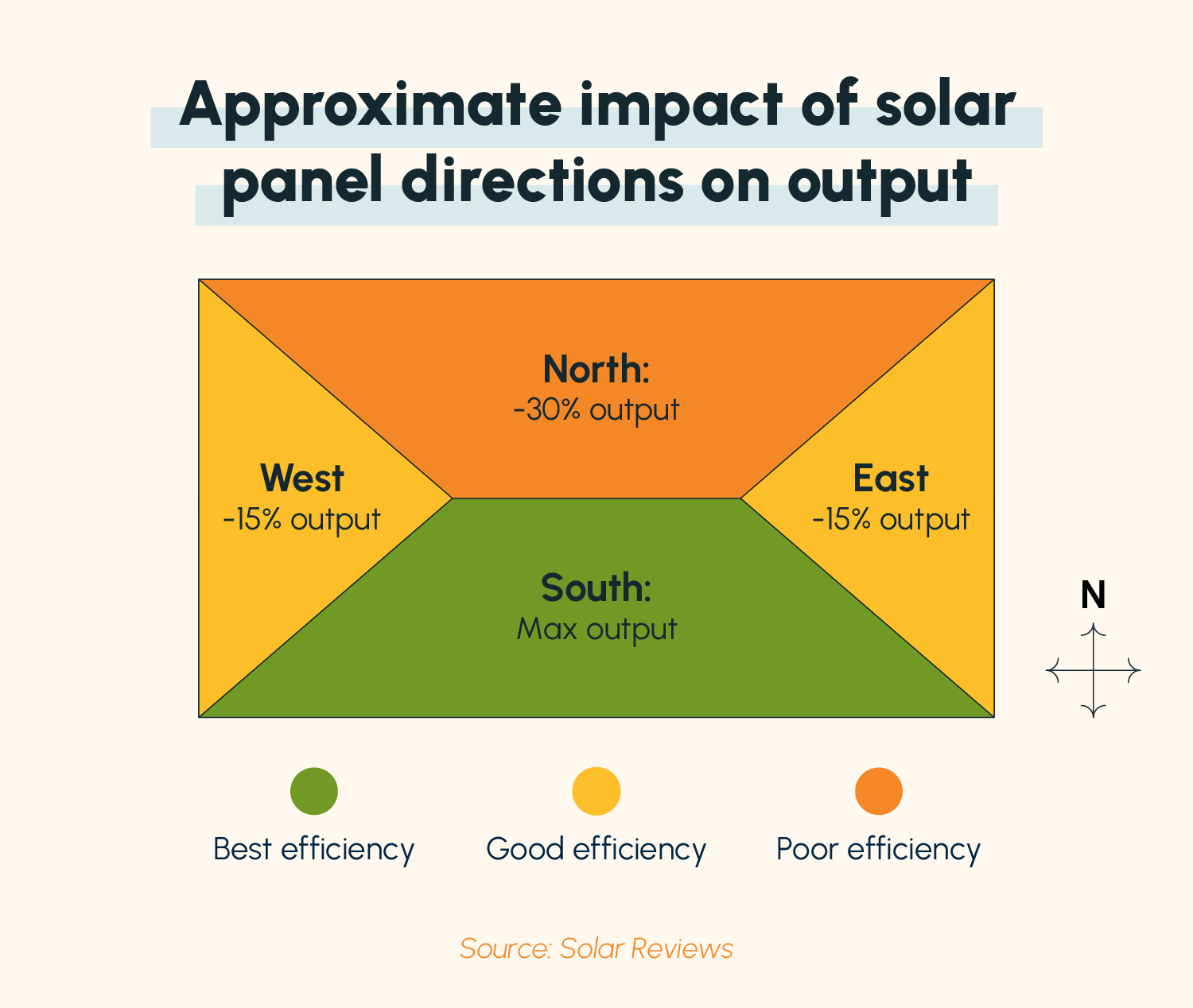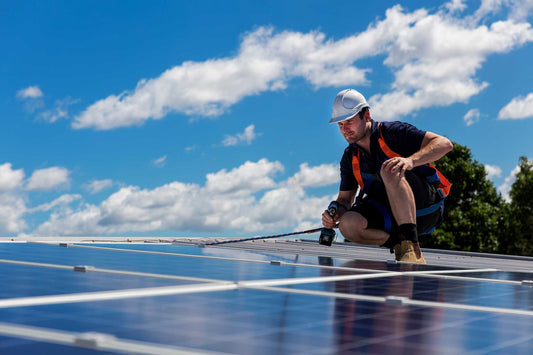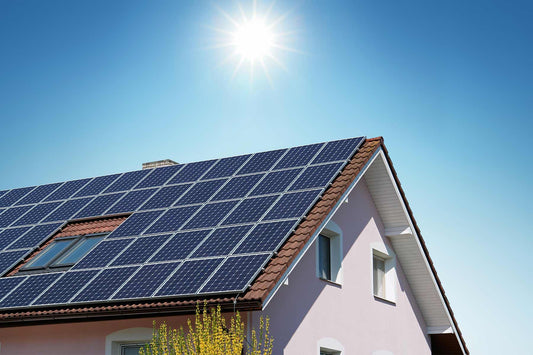Generally, if you live in the Northern Hemisphere, the best direction for solar panels is true south. This is because facing your panels toward the equator and the Tropic of Cancer will result in the highest energy output possible.
Getting the most out of your solar panel system requires some planning.
Aside from choosing panels with a high efficiency rating, setting them up properly will allow them to generate electricity at their full potential. During setup, the most important positioning considerations are solar panel direction and angle.
In the Northern Hemisphere, the best direction for solar panels tends to be true south. That said, there is an argument for positioning panels to face southwest in order to take advantage of evening sunlight.
In this guide, we unpack these panel orientations and explain how to determine the ideal solar panel angle so that you can feel confident about your setup.
Table of Contents:
- Best Solar Panel Direction
- Reasons to Consider a Southwest Orientation
- Best Angle for Solar Panels
- Impact of Solar Panel Direction on Output
- Solar Panel Orientation FAQ
Best Solar Panel Direction: Why True South?
Generally, true south is the best solar panel orientation for people living in the Northern Hemisphere (which includes all of North America).
There are a couple of reasons why this direction is preferred over others: overall energy output and use of surplus energy. Below, we describe these reasons in detail.
Highest Energy Output

Solar panels generate the most energy when directly facing the sun.
As you may remember from science class, the sun points most directly toward the Earth’s equator. Since the Northern Hemisphere is located to the north of the equator, anything facing south will be facing the equator.
For this reason, solar panels on the Northern Hemisphere operate most efficiently when facing true south. This also means that any solar panels on the Southern Hemisphere (take South America, Africa, and Australia, for example), perform best when facing true north.
Best for Collecting Surplus Energy and Net Metering
It’s important to note that south-facing panels generate the highest quantity of energy overall. Much of this energy is generated in the mid-afternoon when the sun is high in the sky.
While much of this energy often isn’t used at the time of collection (because it’s when many people are out of the house and not using electronics), it can still be stored in solar batteries for later use or used for net metering.
Net metering is the process of transferring excess solar energy you produce to the grid for credits from your utility company. This offsets the cost of using energy from the grid when your solar system isn’t generating much (if any) energy, such as at night.
Reasons to Consider a Southwest Orientation
Not every homeowner will want south-facing solar panels. There is a valid case for positioning panels either fully or partially toward the west, which we unpack below.
Evening Solar Production
Household energy use tends to peak in the late afternoon or early evening. Unfortunately, this is when the sun starts to set in the west and UV rays decline, meaning south-facing panels generate very little energy when it’s needed most.
For this reason, some homeowners like to position their panels toward the west to generate as much energy as possible later in the day, when more appliances and electronics are being used.
While this direction results in less overall solar energy production, it may be preferable among households that use significant energy in the evening and do not have much (if any) solar battery storage available.
Time-of-Use (TOU) Rate Structure

Time-of-use (TOU) rate structures refer to electricity plans that charge homeowners differently depending on what time of day they use electricity from the grid. With a TOU, energy costs more during peak hours (usually 4:00 p.m. to 9:00 p.m.) and less during hours outside of this window.
Since electricity costs more when the sun is beginning to set in the west, homeowners with a TOU plan may reap a higher reward from their solar system by installing their panels with a west- or southwest-facing orientation.
Of course, optimal orientation for those with TOU plans varies based on how high peak rates get. If they’re three times as high as off-peak rates, homeowners will want to position their panels further west than if peak rates are only twice that of off-peak rates.
Best Angle for Solar Panels
Just as the direction of your panels depends on your location in the world, so does the angle or tilt of your panels.
Generally, the best angle for solar panels is whatever your geographical latitude is. If your home is located at 35 degrees north, you should set the tilt angle of your panels to 35 degrees so that they’re pointed most directly at the equator.
Simply put, the closer solar panels are to the equator, the more they should be pointed straight up. The further they are from the equator, the greater their tilt should be.
That said, it’s important to also be aware that the likelihood of dirt and debris collection is higher when panels are facing straight up. Low-tilt panels (closer to zero degrees) should therefore be inspected and cleaned more often than high-tilt panels (closer to 90 degrees).
Impact of Solar Panel Direction on Output

If your panels point anywhere except true south, you can expect them to decrease in output to a degree. That said, this decrease depends on which direction they point. See the table below approximating how much energy is lost with every direction that isn’t true south.
While most of the time panel output will decrease by less than 30% when pointed in a suboptimal direction, a few factors can impact this number and bring production even lower. These include:
- Degrees from south: Every degree that panels are turned away from true south will negatively impact overall production. Panels facing southwest and southeast experience a slight drop, east and west a moderate drop, and north a significant drop.
- Distance from equator: Panels located further from the equator will see a more significant decline in energy production when they aren’t facing south than those closer to the equator. West-facing panels in New York City lose significantly more output than west-facing panels in Dallas.
- Roof pitch: Solar panels on steeper non-south-facing roofs experience a more significant energy production drop than panels on flatter non-south-facing roofs. This is because steeper roofs point panels more directly in a non-optimal direction.
Solar Panel Orientation FAQ
There isn’t one hard-and-fast rule about solar panel direction and angle — much of it has to do with personal preference. For this reason, it’s natural to have some clarifying questions before determining the best direction or location for your own solar panels. Below, we answer some common ones.
What Direction Should Solar Panels Face?
Most people living in North America (and anywhere else in the Northern Hemisphere) will likely want to have their panels facing true south, as this is the direction that yields the highest rate of energy production.
This holds especially true for homes with solar batteries or those that want to participate in a net metering program, as these situations ensure that energy collected during peak hours doesn’t go to waste.
For those with a TOU plan that has a high discrepancy between peak and off-peak rates, a southwest orientation might be preferable to offset the high costs of energy in the evening.
What If My Roof Doesn’t Face South?
If your roof doesn’t face true south, don’t fret. You can still reap the benefits of solar without an ideal roof layout.
If you’re concerned about the reduced output of solar panels on a roof that doesn’t face south, you have some options to increase output:
- Install more panels: Increasing the size of your system, even if those additional panels also aren’t able to produce electricity at their full potential, will likely offset any energy loss due to a sub-optimally positioned roof.
- Install a ground-mounted solar array: If you have the space to do so, you can install your solar system on the ground rather than on top of your roof. This provides more panel angle flexibility and a clearer view of the sun.
Why Do Solar Panels Face South?
It’s common knowledge that the more sunlight solar panels receive, the more energy they can produce.
The sun shines most directly at the Earth’s equator (which divides the Earth horizontally). Homes in the Northern Hemisphere should face their solar panels true south to point them toward the equator. This allows panels to collect the most solar energy possible.
What Is the Best Angle for Solar Panels?
The best angle for solar panels is whatever your geographical latitude is. If you live in Los Angeles (located at 34 degrees north), your ideal tilt angle will also be 34 degrees.
The closer you are to the equator, the more your panels should be pointed straight up. The further you are, the more your panels should be tilted.
Once you’ve determined your own best direction for solar panels, you’re ready to move forward with installation.
With Solartap, finding a reputable installer in your area and getting our premium panels up and running is easier than ever. Get started today!




